Outsourcing: Advantages, Disadvantages, and Global Business Impact
VerifiedAdded on 2021/12/17
|11
|2827
|95
Essay
AI Summary
This essay delves into the multifaceted world of outsourcing within the global business context. It begins by defining outsourcing and its role in enhancing competitiveness, allowing businesses to focus on core competencies while leveraging external expertise for efficiency and cost-effectiveness. The essay explores both the advantages, such as market competitiveness, cost reduction, access to superior quality, and risk sharing, and the disadvantages, including security threats, loss of managerial control, and potential quality issues. Real-world examples, like McDonald's and Apple Inc., illustrate how outsourcing strategies can lead to global expansion and operational improvements. The paper also highlights the complexities and potential pitfalls of outsourcing, such as integration challenges and the risk of project failures. By examining both sides of the coin, the essay aims to provide a comprehensive understanding of outsourcing's strategic importance and its impact on business performance in an increasingly interconnected world.

Define and discuss advantages and
disadvantages of outsourcing and the
role it plays in a global context.
Managing
Across
Borders
Institutional Affiliation(s)
Student Name
disadvantages of outsourcing and the
role it plays in a global context.
Managing
Across
Borders
Institutional Affiliation(s)
Student Name
Paraphrase This Document
Need a fresh take? Get an instant paraphrase of this document with our AI Paraphraser
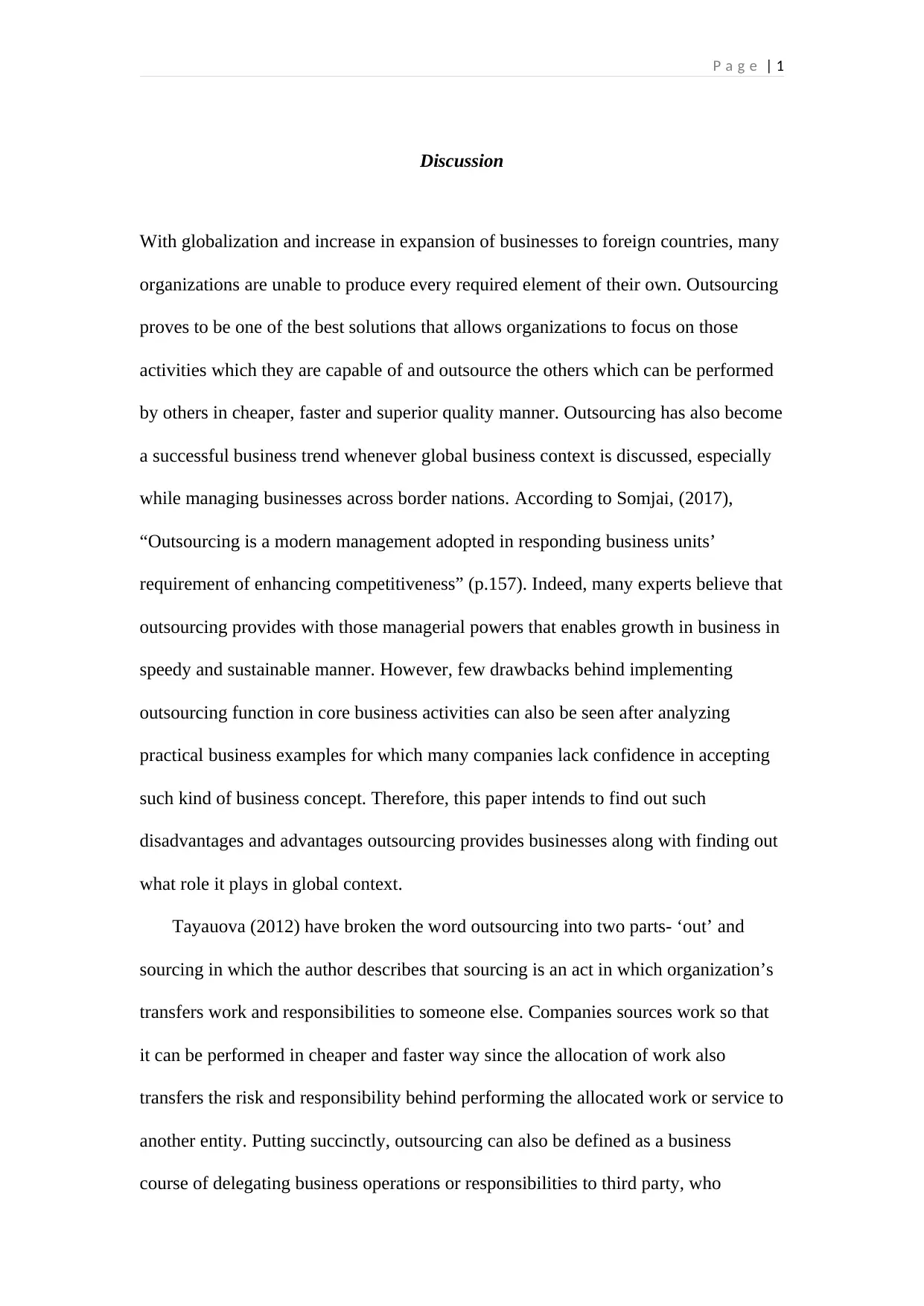
P a g e | 1
Discussion
With globalization and increase in expansion of businesses to foreign countries, many
organizations are unable to produce every required element of their own. Outsourcing
proves to be one of the best solutions that allows organizations to focus on those
activities which they are capable of and outsource the others which can be performed
by others in cheaper, faster and superior quality manner. Outsourcing has also become
a successful business trend whenever global business context is discussed, especially
while managing businesses across border nations. According to Somjai, (2017),
“Outsourcing is a modern management adopted in responding business units’
requirement of enhancing competitiveness” (p.157). Indeed, many experts believe that
outsourcing provides with those managerial powers that enables growth in business in
speedy and sustainable manner. However, few drawbacks behind implementing
outsourcing function in core business activities can also be seen after analyzing
practical business examples for which many companies lack confidence in accepting
such kind of business concept. Therefore, this paper intends to find out such
disadvantages and advantages outsourcing provides businesses along with finding out
what role it plays in global context.
Tayauova (2012) have broken the word outsourcing into two parts- ‘out’ and
sourcing in which the author describes that sourcing is an act in which organization’s
transfers work and responsibilities to someone else. Companies sources work so that
it can be performed in cheaper and faster way since the allocation of work also
transfers the risk and responsibility behind performing the allocated work or service to
another entity. Putting succinctly, outsourcing can also be defined as a business
course of delegating business operations or responsibilities to third party, who
Discussion
With globalization and increase in expansion of businesses to foreign countries, many
organizations are unable to produce every required element of their own. Outsourcing
proves to be one of the best solutions that allows organizations to focus on those
activities which they are capable of and outsource the others which can be performed
by others in cheaper, faster and superior quality manner. Outsourcing has also become
a successful business trend whenever global business context is discussed, especially
while managing businesses across border nations. According to Somjai, (2017),
“Outsourcing is a modern management adopted in responding business units’
requirement of enhancing competitiveness” (p.157). Indeed, many experts believe that
outsourcing provides with those managerial powers that enables growth in business in
speedy and sustainable manner. However, few drawbacks behind implementing
outsourcing function in core business activities can also be seen after analyzing
practical business examples for which many companies lack confidence in accepting
such kind of business concept. Therefore, this paper intends to find out such
disadvantages and advantages outsourcing provides businesses along with finding out
what role it plays in global context.
Tayauova (2012) have broken the word outsourcing into two parts- ‘out’ and
sourcing in which the author describes that sourcing is an act in which organization’s
transfers work and responsibilities to someone else. Companies sources work so that
it can be performed in cheaper and faster way since the allocation of work also
transfers the risk and responsibility behind performing the allocated work or service to
another entity. Putting succinctly, outsourcing can also be defined as a business
course of delegating business operations or responsibilities to third party, who
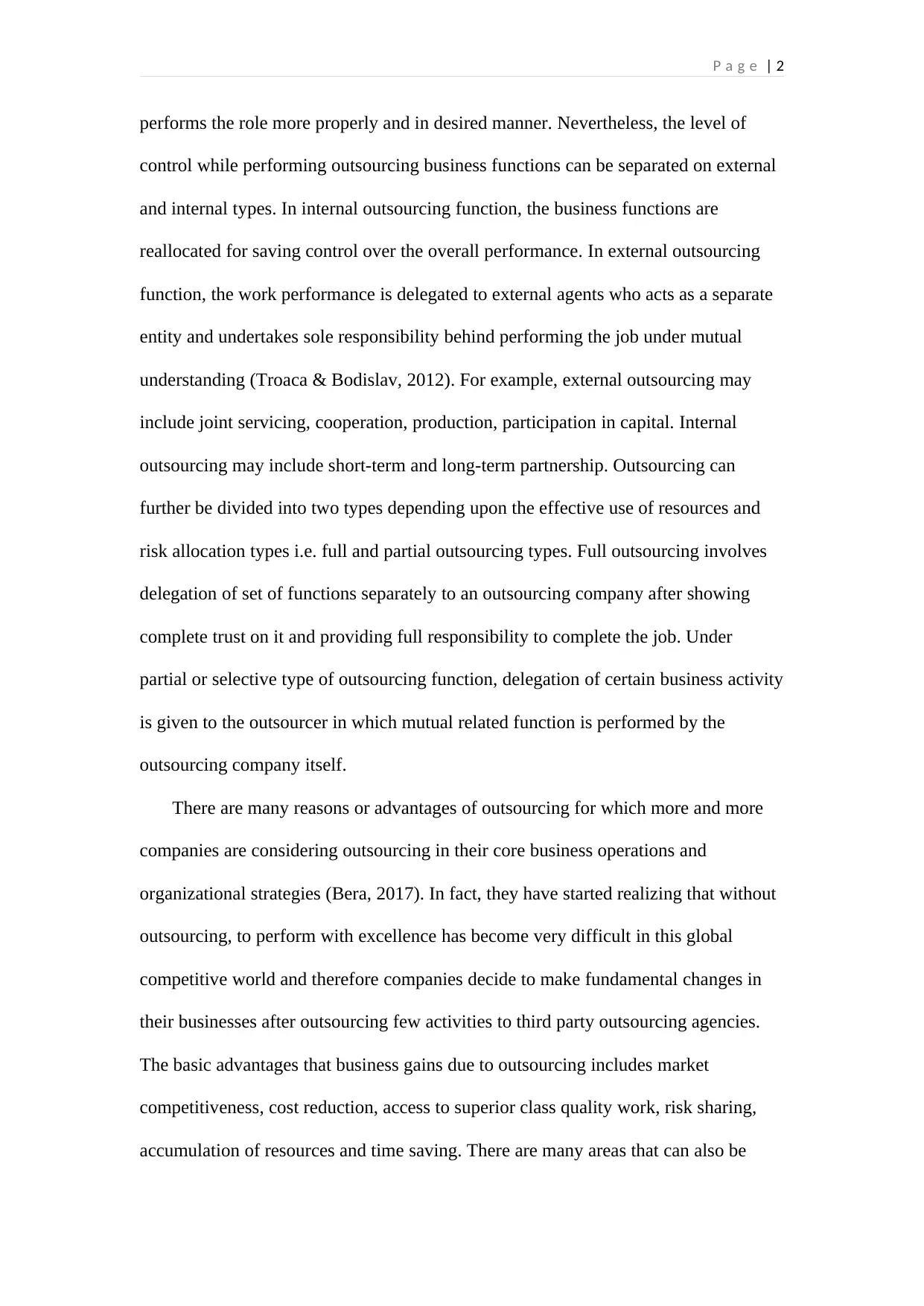
P a g e | 2
performs the role more properly and in desired manner. Nevertheless, the level of
control while performing outsourcing business functions can be separated on external
and internal types. In internal outsourcing function, the business functions are
reallocated for saving control over the overall performance. In external outsourcing
function, the work performance is delegated to external agents who acts as a separate
entity and undertakes sole responsibility behind performing the job under mutual
understanding (Troaca & Bodislav, 2012). For example, external outsourcing may
include joint servicing, cooperation, production, participation in capital. Internal
outsourcing may include short-term and long-term partnership. Outsourcing can
further be divided into two types depending upon the effective use of resources and
risk allocation types i.e. full and partial outsourcing types. Full outsourcing involves
delegation of set of functions separately to an outsourcing company after showing
complete trust on it and providing full responsibility to complete the job. Under
partial or selective type of outsourcing function, delegation of certain business activity
is given to the outsourcer in which mutual related function is performed by the
outsourcing company itself.
There are many reasons or advantages of outsourcing for which more and more
companies are considering outsourcing in their core business operations and
organizational strategies (Bera, 2017). In fact, they have started realizing that without
outsourcing, to perform with excellence has become very difficult in this global
competitive world and therefore companies decide to make fundamental changes in
their businesses after outsourcing few activities to third party outsourcing agencies.
The basic advantages that business gains due to outsourcing includes market
competitiveness, cost reduction, access to superior class quality work, risk sharing,
accumulation of resources and time saving. There are many areas that can also be
performs the role more properly and in desired manner. Nevertheless, the level of
control while performing outsourcing business functions can be separated on external
and internal types. In internal outsourcing function, the business functions are
reallocated for saving control over the overall performance. In external outsourcing
function, the work performance is delegated to external agents who acts as a separate
entity and undertakes sole responsibility behind performing the job under mutual
understanding (Troaca & Bodislav, 2012). For example, external outsourcing may
include joint servicing, cooperation, production, participation in capital. Internal
outsourcing may include short-term and long-term partnership. Outsourcing can
further be divided into two types depending upon the effective use of resources and
risk allocation types i.e. full and partial outsourcing types. Full outsourcing involves
delegation of set of functions separately to an outsourcing company after showing
complete trust on it and providing full responsibility to complete the job. Under
partial or selective type of outsourcing function, delegation of certain business activity
is given to the outsourcer in which mutual related function is performed by the
outsourcing company itself.
There are many reasons or advantages of outsourcing for which more and more
companies are considering outsourcing in their core business operations and
organizational strategies (Bera, 2017). In fact, they have started realizing that without
outsourcing, to perform with excellence has become very difficult in this global
competitive world and therefore companies decide to make fundamental changes in
their businesses after outsourcing few activities to third party outsourcing agencies.
The basic advantages that business gains due to outsourcing includes market
competitiveness, cost reduction, access to superior class quality work, risk sharing,
accumulation of resources and time saving. There are many areas that can also be
⊘ This is a preview!⊘
Do you want full access?
Subscribe today to unlock all pages.

Trusted by 1+ million students worldwide
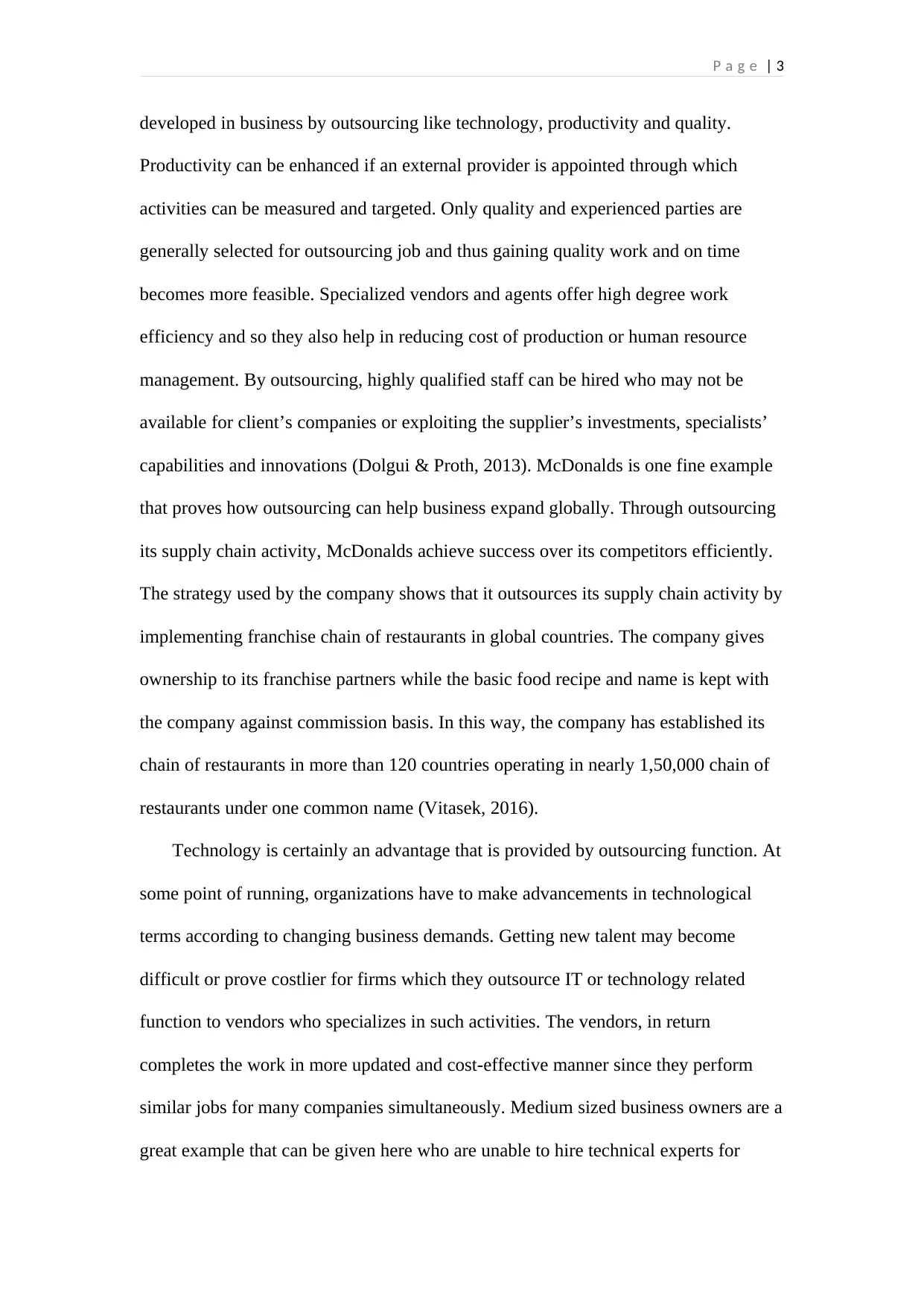
P a g e | 3
developed in business by outsourcing like technology, productivity and quality.
Productivity can be enhanced if an external provider is appointed through which
activities can be measured and targeted. Only quality and experienced parties are
generally selected for outsourcing job and thus gaining quality work and on time
becomes more feasible. Specialized vendors and agents offer high degree work
efficiency and so they also help in reducing cost of production or human resource
management. By outsourcing, highly qualified staff can be hired who may not be
available for client’s companies or exploiting the supplier’s investments, specialists’
capabilities and innovations (Dolgui & Proth, 2013). McDonalds is one fine example
that proves how outsourcing can help business expand globally. Through outsourcing
its supply chain activity, McDonalds achieve success over its competitors efficiently.
The strategy used by the company shows that it outsources its supply chain activity by
implementing franchise chain of restaurants in global countries. The company gives
ownership to its franchise partners while the basic food recipe and name is kept with
the company against commission basis. In this way, the company has established its
chain of restaurants in more than 120 countries operating in nearly 1,50,000 chain of
restaurants under one common name (Vitasek, 2016).
Technology is certainly an advantage that is provided by outsourcing function. At
some point of running, organizations have to make advancements in technological
terms according to changing business demands. Getting new talent may become
difficult or prove costlier for firms which they outsource IT or technology related
function to vendors who specializes in such activities. The vendors, in return
completes the work in more updated and cost-effective manner since they perform
similar jobs for many companies simultaneously. Medium sized business owners are a
great example that can be given here who are unable to hire technical experts for
developed in business by outsourcing like technology, productivity and quality.
Productivity can be enhanced if an external provider is appointed through which
activities can be measured and targeted. Only quality and experienced parties are
generally selected for outsourcing job and thus gaining quality work and on time
becomes more feasible. Specialized vendors and agents offer high degree work
efficiency and so they also help in reducing cost of production or human resource
management. By outsourcing, highly qualified staff can be hired who may not be
available for client’s companies or exploiting the supplier’s investments, specialists’
capabilities and innovations (Dolgui & Proth, 2013). McDonalds is one fine example
that proves how outsourcing can help business expand globally. Through outsourcing
its supply chain activity, McDonalds achieve success over its competitors efficiently.
The strategy used by the company shows that it outsources its supply chain activity by
implementing franchise chain of restaurants in global countries. The company gives
ownership to its franchise partners while the basic food recipe and name is kept with
the company against commission basis. In this way, the company has established its
chain of restaurants in more than 120 countries operating in nearly 1,50,000 chain of
restaurants under one common name (Vitasek, 2016).
Technology is certainly an advantage that is provided by outsourcing function. At
some point of running, organizations have to make advancements in technological
terms according to changing business demands. Getting new talent may become
difficult or prove costlier for firms which they outsource IT or technology related
function to vendors who specializes in such activities. The vendors, in return
completes the work in more updated and cost-effective manner since they perform
similar jobs for many companies simultaneously. Medium sized business owners are a
great example that can be given here who are unable to hire technical experts for
Paraphrase This Document
Need a fresh take? Get an instant paraphrase of this document with our AI Paraphraser
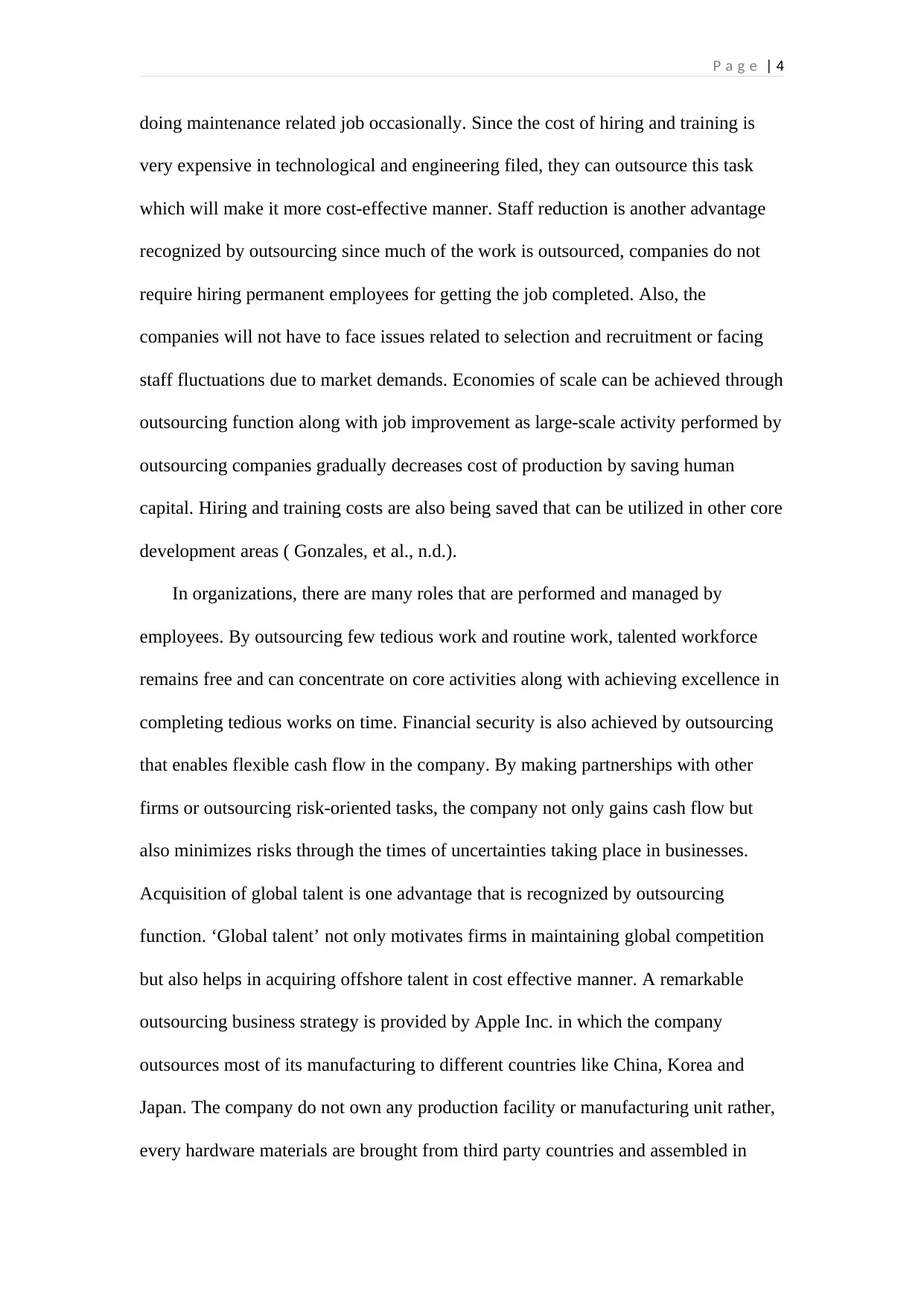
P a g e | 4
doing maintenance related job occasionally. Since the cost of hiring and training is
very expensive in technological and engineering filed, they can outsource this task
which will make it more cost-effective manner. Staff reduction is another advantage
recognized by outsourcing since much of the work is outsourced, companies do not
require hiring permanent employees for getting the job completed. Also, the
companies will not have to face issues related to selection and recruitment or facing
staff fluctuations due to market demands. Economies of scale can be achieved through
outsourcing function along with job improvement as large-scale activity performed by
outsourcing companies gradually decreases cost of production by saving human
capital. Hiring and training costs are also being saved that can be utilized in other core
development areas ( Gonzales, et al., n.d.).
In organizations, there are many roles that are performed and managed by
employees. By outsourcing few tedious work and routine work, talented workforce
remains free and can concentrate on core activities along with achieving excellence in
completing tedious works on time. Financial security is also achieved by outsourcing
that enables flexible cash flow in the company. By making partnerships with other
firms or outsourcing risk-oriented tasks, the company not only gains cash flow but
also minimizes risks through the times of uncertainties taking place in businesses.
Acquisition of global talent is one advantage that is recognized by outsourcing
function. ‘Global talent’ not only motivates firms in maintaining global competition
but also helps in acquiring offshore talent in cost effective manner. A remarkable
outsourcing business strategy is provided by Apple Inc. in which the company
outsources most of its manufacturing to different countries like China, Korea and
Japan. The company do not own any production facility or manufacturing unit rather,
every hardware materials are brought from third party countries and assembled in
doing maintenance related job occasionally. Since the cost of hiring and training is
very expensive in technological and engineering filed, they can outsource this task
which will make it more cost-effective manner. Staff reduction is another advantage
recognized by outsourcing since much of the work is outsourced, companies do not
require hiring permanent employees for getting the job completed. Also, the
companies will not have to face issues related to selection and recruitment or facing
staff fluctuations due to market demands. Economies of scale can be achieved through
outsourcing function along with job improvement as large-scale activity performed by
outsourcing companies gradually decreases cost of production by saving human
capital. Hiring and training costs are also being saved that can be utilized in other core
development areas ( Gonzales, et al., n.d.).
In organizations, there are many roles that are performed and managed by
employees. By outsourcing few tedious work and routine work, talented workforce
remains free and can concentrate on core activities along with achieving excellence in
completing tedious works on time. Financial security is also achieved by outsourcing
that enables flexible cash flow in the company. By making partnerships with other
firms or outsourcing risk-oriented tasks, the company not only gains cash flow but
also minimizes risks through the times of uncertainties taking place in businesses.
Acquisition of global talent is one advantage that is recognized by outsourcing
function. ‘Global talent’ not only motivates firms in maintaining global competition
but also helps in acquiring offshore talent in cost effective manner. A remarkable
outsourcing business strategy is provided by Apple Inc. in which the company
outsources most of its manufacturing to different countries like China, Korea and
Japan. The company do not own any production facility or manufacturing unit rather,
every hardware materials are brought from third party countries and assembled in
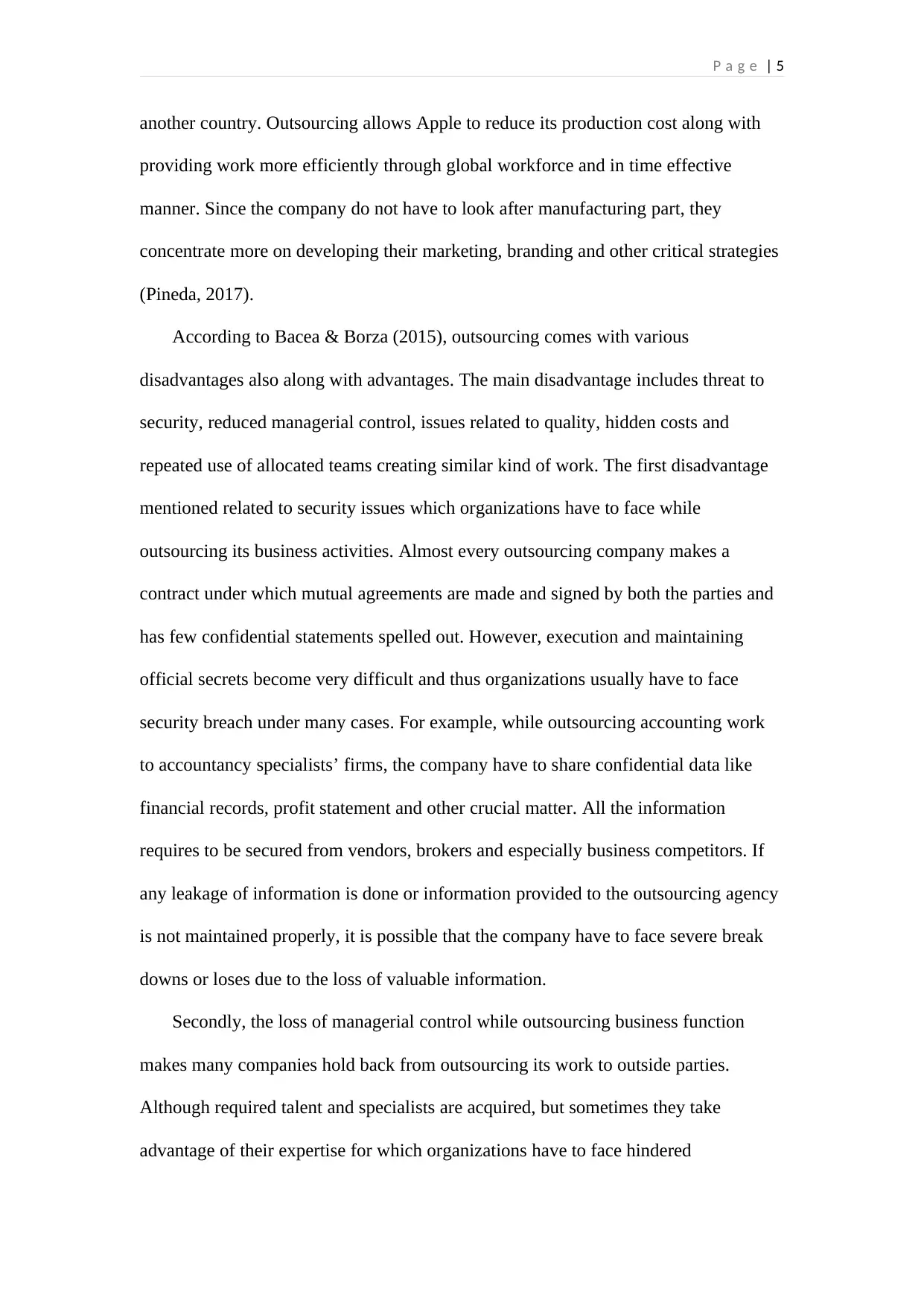
P a g e | 5
another country. Outsourcing allows Apple to reduce its production cost along with
providing work more efficiently through global workforce and in time effective
manner. Since the company do not have to look after manufacturing part, they
concentrate more on developing their marketing, branding and other critical strategies
(Pineda, 2017).
According to Bacea & Borza (2015), outsourcing comes with various
disadvantages also along with advantages. The main disadvantage includes threat to
security, reduced managerial control, issues related to quality, hidden costs and
repeated use of allocated teams creating similar kind of work. The first disadvantage
mentioned related to security issues which organizations have to face while
outsourcing its business activities. Almost every outsourcing company makes a
contract under which mutual agreements are made and signed by both the parties and
has few confidential statements spelled out. However, execution and maintaining
official secrets become very difficult and thus organizations usually have to face
security breach under many cases. For example, while outsourcing accounting work
to accountancy specialists’ firms, the company have to share confidential data like
financial records, profit statement and other crucial matter. All the information
requires to be secured from vendors, brokers and especially business competitors. If
any leakage of information is done or information provided to the outsourcing agency
is not maintained properly, it is possible that the company have to face severe break
downs or loses due to the loss of valuable information.
Secondly, the loss of managerial control while outsourcing business function
makes many companies hold back from outsourcing its work to outside parties.
Although required talent and specialists are acquired, but sometimes they take
advantage of their expertise for which organizations have to face hindered
another country. Outsourcing allows Apple to reduce its production cost along with
providing work more efficiently through global workforce and in time effective
manner. Since the company do not have to look after manufacturing part, they
concentrate more on developing their marketing, branding and other critical strategies
(Pineda, 2017).
According to Bacea & Borza (2015), outsourcing comes with various
disadvantages also along with advantages. The main disadvantage includes threat to
security, reduced managerial control, issues related to quality, hidden costs and
repeated use of allocated teams creating similar kind of work. The first disadvantage
mentioned related to security issues which organizations have to face while
outsourcing its business activities. Almost every outsourcing company makes a
contract under which mutual agreements are made and signed by both the parties and
has few confidential statements spelled out. However, execution and maintaining
official secrets become very difficult and thus organizations usually have to face
security breach under many cases. For example, while outsourcing accounting work
to accountancy specialists’ firms, the company have to share confidential data like
financial records, profit statement and other crucial matter. All the information
requires to be secured from vendors, brokers and especially business competitors. If
any leakage of information is done or information provided to the outsourcing agency
is not maintained properly, it is possible that the company have to face severe break
downs or loses due to the loss of valuable information.
Secondly, the loss of managerial control while outsourcing business function
makes many companies hold back from outsourcing its work to outside parties.
Although required talent and specialists are acquired, but sometimes they take
advantage of their expertise for which organizations have to face hindered
⊘ This is a preview!⊘
Do you want full access?
Subscribe today to unlock all pages.

Trusted by 1+ million students worldwide
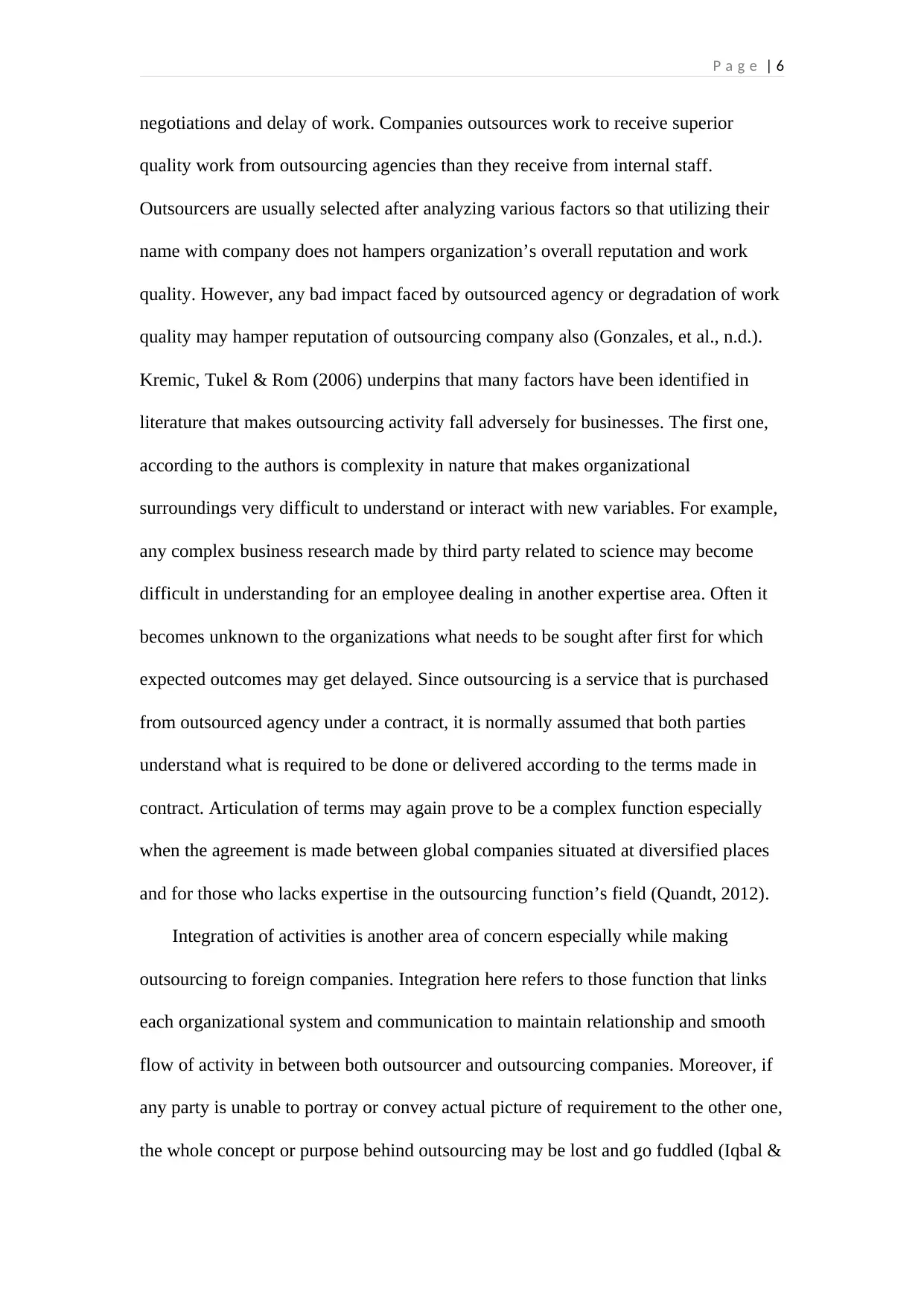
P a g e | 6
negotiations and delay of work. Companies outsources work to receive superior
quality work from outsourcing agencies than they receive from internal staff.
Outsourcers are usually selected after analyzing various factors so that utilizing their
name with company does not hampers organization’s overall reputation and work
quality. However, any bad impact faced by outsourced agency or degradation of work
quality may hamper reputation of outsourcing company also (Gonzales, et al., n.d.).
Kremic, Tukel & Rom (2006) underpins that many factors have been identified in
literature that makes outsourcing activity fall adversely for businesses. The first one,
according to the authors is complexity in nature that makes organizational
surroundings very difficult to understand or interact with new variables. For example,
any complex business research made by third party related to science may become
difficult in understanding for an employee dealing in another expertise area. Often it
becomes unknown to the organizations what needs to be sought after first for which
expected outcomes may get delayed. Since outsourcing is a service that is purchased
from outsourced agency under a contract, it is normally assumed that both parties
understand what is required to be done or delivered according to the terms made in
contract. Articulation of terms may again prove to be a complex function especially
when the agreement is made between global companies situated at diversified places
and for those who lacks expertise in the outsourcing function’s field (Quandt, 2012).
Integration of activities is another area of concern especially while making
outsourcing to foreign companies. Integration here refers to those function that links
each organizational system and communication to maintain relationship and smooth
flow of activity in between both outsourcer and outsourcing companies. Moreover, if
any party is unable to portray or convey actual picture of requirement to the other one,
the whole concept or purpose behind outsourcing may be lost and go fuddled (Iqbal &
negotiations and delay of work. Companies outsources work to receive superior
quality work from outsourcing agencies than they receive from internal staff.
Outsourcers are usually selected after analyzing various factors so that utilizing their
name with company does not hampers organization’s overall reputation and work
quality. However, any bad impact faced by outsourced agency or degradation of work
quality may hamper reputation of outsourcing company also (Gonzales, et al., n.d.).
Kremic, Tukel & Rom (2006) underpins that many factors have been identified in
literature that makes outsourcing activity fall adversely for businesses. The first one,
according to the authors is complexity in nature that makes organizational
surroundings very difficult to understand or interact with new variables. For example,
any complex business research made by third party related to science may become
difficult in understanding for an employee dealing in another expertise area. Often it
becomes unknown to the organizations what needs to be sought after first for which
expected outcomes may get delayed. Since outsourcing is a service that is purchased
from outsourced agency under a contract, it is normally assumed that both parties
understand what is required to be done or delivered according to the terms made in
contract. Articulation of terms may again prove to be a complex function especially
when the agreement is made between global companies situated at diversified places
and for those who lacks expertise in the outsourcing function’s field (Quandt, 2012).
Integration of activities is another area of concern especially while making
outsourcing to foreign companies. Integration here refers to those function that links
each organizational system and communication to maintain relationship and smooth
flow of activity in between both outsourcer and outsourcing companies. Moreover, if
any party is unable to portray or convey actual picture of requirement to the other one,
the whole concept or purpose behind outsourcing may be lost and go fuddled (Iqbal &
Paraphrase This Document
Need a fresh take? Get an instant paraphrase of this document with our AI Paraphraser
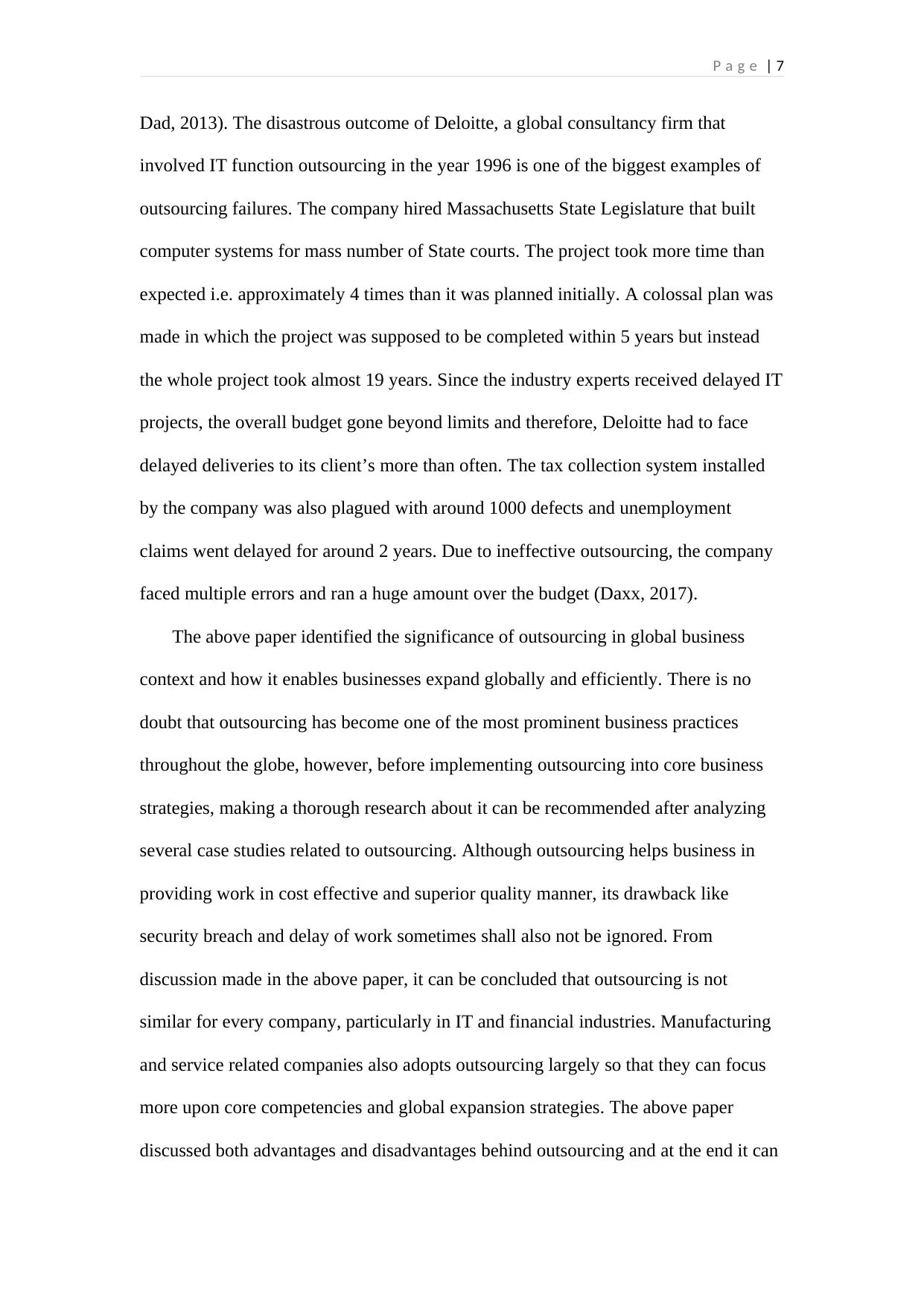
P a g e | 7
Dad, 2013). The disastrous outcome of Deloitte, a global consultancy firm that
involved IT function outsourcing in the year 1996 is one of the biggest examples of
outsourcing failures. The company hired Massachusetts State Legislature that built
computer systems for mass number of State courts. The project took more time than
expected i.e. approximately 4 times than it was planned initially. A colossal plan was
made in which the project was supposed to be completed within 5 years but instead
the whole project took almost 19 years. Since the industry experts received delayed IT
projects, the overall budget gone beyond limits and therefore, Deloitte had to face
delayed deliveries to its client’s more than often. The tax collection system installed
by the company was also plagued with around 1000 defects and unemployment
claims went delayed for around 2 years. Due to ineffective outsourcing, the company
faced multiple errors and ran a huge amount over the budget (Daxx, 2017).
The above paper identified the significance of outsourcing in global business
context and how it enables businesses expand globally and efficiently. There is no
doubt that outsourcing has become one of the most prominent business practices
throughout the globe, however, before implementing outsourcing into core business
strategies, making a thorough research about it can be recommended after analyzing
several case studies related to outsourcing. Although outsourcing helps business in
providing work in cost effective and superior quality manner, its drawback like
security breach and delay of work sometimes shall also not be ignored. From
discussion made in the above paper, it can be concluded that outsourcing is not
similar for every company, particularly in IT and financial industries. Manufacturing
and service related companies also adopts outsourcing largely so that they can focus
more upon core competencies and global expansion strategies. The above paper
discussed both advantages and disadvantages behind outsourcing and at the end it can
Dad, 2013). The disastrous outcome of Deloitte, a global consultancy firm that
involved IT function outsourcing in the year 1996 is one of the biggest examples of
outsourcing failures. The company hired Massachusetts State Legislature that built
computer systems for mass number of State courts. The project took more time than
expected i.e. approximately 4 times than it was planned initially. A colossal plan was
made in which the project was supposed to be completed within 5 years but instead
the whole project took almost 19 years. Since the industry experts received delayed IT
projects, the overall budget gone beyond limits and therefore, Deloitte had to face
delayed deliveries to its client’s more than often. The tax collection system installed
by the company was also plagued with around 1000 defects and unemployment
claims went delayed for around 2 years. Due to ineffective outsourcing, the company
faced multiple errors and ran a huge amount over the budget (Daxx, 2017).
The above paper identified the significance of outsourcing in global business
context and how it enables businesses expand globally and efficiently. There is no
doubt that outsourcing has become one of the most prominent business practices
throughout the globe, however, before implementing outsourcing into core business
strategies, making a thorough research about it can be recommended after analyzing
several case studies related to outsourcing. Although outsourcing helps business in
providing work in cost effective and superior quality manner, its drawback like
security breach and delay of work sometimes shall also not be ignored. From
discussion made in the above paper, it can be concluded that outsourcing is not
similar for every company, particularly in IT and financial industries. Manufacturing
and service related companies also adopts outsourcing largely so that they can focus
more upon core competencies and global expansion strategies. The above paper
discussed both advantages and disadvantages behind outsourcing and at the end it can
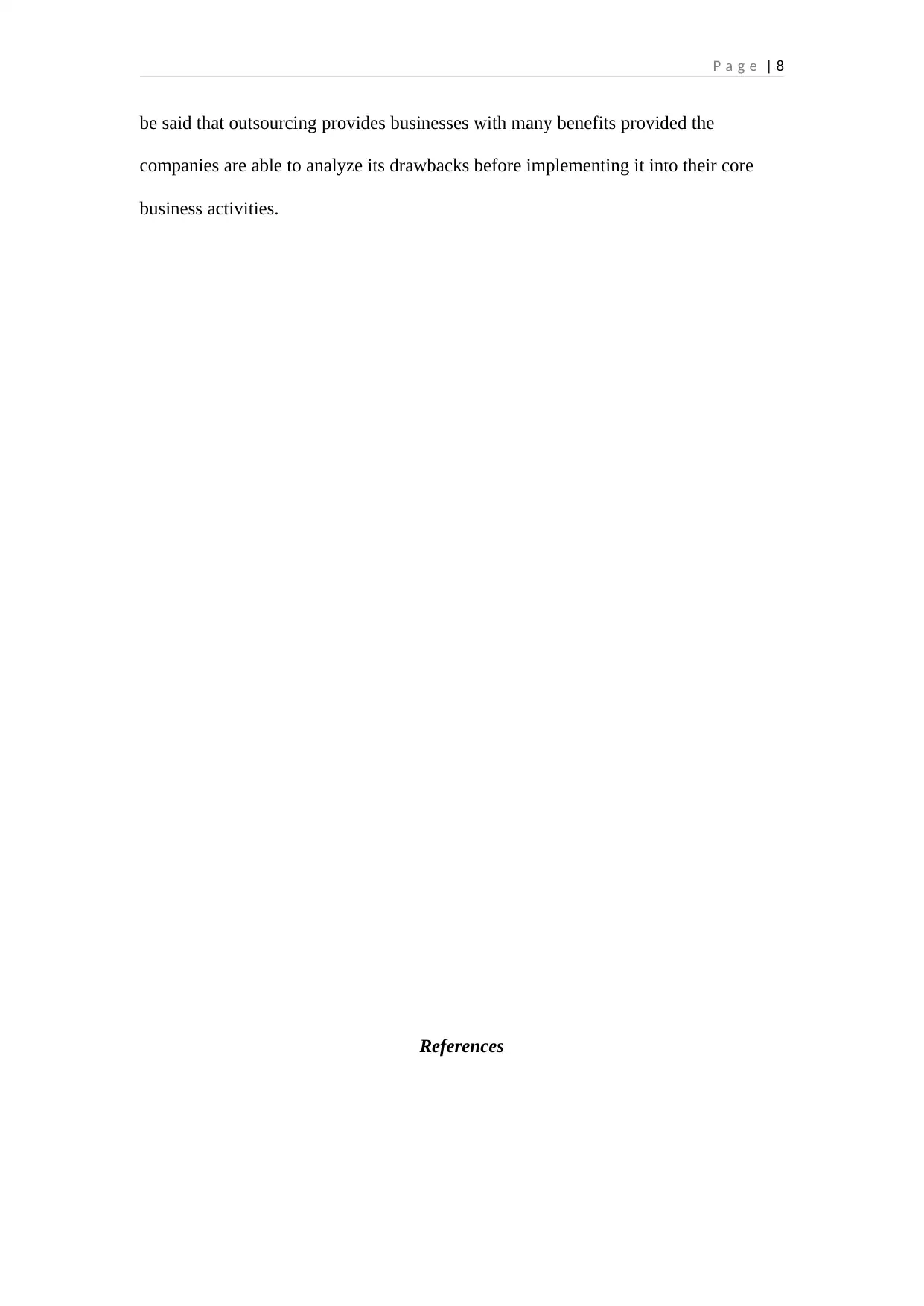
P a g e | 8
be said that outsourcing provides businesses with many benefits provided the
companies are able to analyze its drawbacks before implementing it into their core
business activities.
References
be said that outsourcing provides businesses with many benefits provided the
companies are able to analyze its drawbacks before implementing it into their core
business activities.
References
⊘ This is a preview!⊘
Do you want full access?
Subscribe today to unlock all pages.

Trusted by 1+ million students worldwide
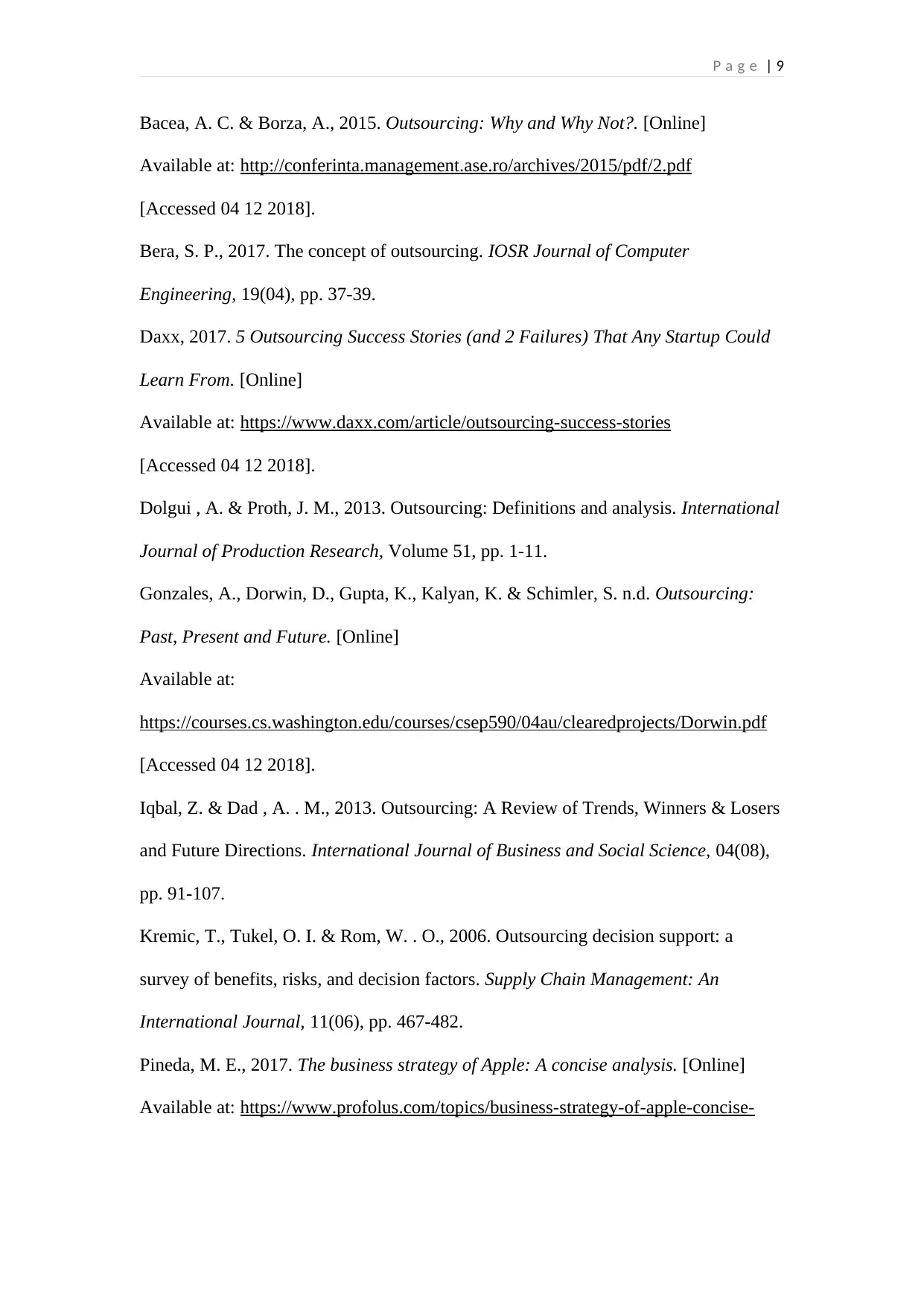
P a g e | 9
Bacea, A. C. & Borza, A., 2015. Outsourcing: Why and Why Not?. [Online]
Available at: http://conferinta.management.ase.ro/archives/2015/pdf/2.pdf
[Accessed 04 12 2018].
Bera, S. P., 2017. The concept of outsourcing. IOSR Journal of Computer
Engineering, 19(04), pp. 37-39.
Daxx, 2017. 5 Outsourcing Success Stories (and 2 Failures) That Any Startup Could
Learn From. [Online]
Available at: https://www.daxx.com/article/outsourcing-success-stories
[Accessed 04 12 2018].
Dolgui , A. & Proth, J. M., 2013. Outsourcing: Definitions and analysis. International
Journal of Production Research, Volume 51, pp. 1-11.
Gonzales, A., Dorwin, D., Gupta, K., Kalyan, K. & Schimler, S. n.d. Outsourcing:
Past, Present and Future. [Online]
Available at:
https://courses.cs.washington.edu/courses/csep590/04au/clearedprojects/Dorwin.pdf
[Accessed 04 12 2018].
Iqbal, Z. & Dad , A. . M., 2013. Outsourcing: A Review of Trends, Winners & Losers
and Future Directions. International Journal of Business and Social Science, 04(08),
pp. 91-107.
Kremic, T., Tukel, O. I. & Rom, W. . O., 2006. Outsourcing decision support: a
survey of benefits, risks, and decision factors. Supply Chain Management: An
International Journal, 11(06), pp. 467-482.
Pineda, M. E., 2017. The business strategy of Apple: A concise analysis. [Online]
Available at: https://www.profolus.com/topics/business-strategy-of-apple-concise-
Bacea, A. C. & Borza, A., 2015. Outsourcing: Why and Why Not?. [Online]
Available at: http://conferinta.management.ase.ro/archives/2015/pdf/2.pdf
[Accessed 04 12 2018].
Bera, S. P., 2017. The concept of outsourcing. IOSR Journal of Computer
Engineering, 19(04), pp. 37-39.
Daxx, 2017. 5 Outsourcing Success Stories (and 2 Failures) That Any Startup Could
Learn From. [Online]
Available at: https://www.daxx.com/article/outsourcing-success-stories
[Accessed 04 12 2018].
Dolgui , A. & Proth, J. M., 2013. Outsourcing: Definitions and analysis. International
Journal of Production Research, Volume 51, pp. 1-11.
Gonzales, A., Dorwin, D., Gupta, K., Kalyan, K. & Schimler, S. n.d. Outsourcing:
Past, Present and Future. [Online]
Available at:
https://courses.cs.washington.edu/courses/csep590/04au/clearedprojects/Dorwin.pdf
[Accessed 04 12 2018].
Iqbal, Z. & Dad , A. . M., 2013. Outsourcing: A Review of Trends, Winners & Losers
and Future Directions. International Journal of Business and Social Science, 04(08),
pp. 91-107.
Kremic, T., Tukel, O. I. & Rom, W. . O., 2006. Outsourcing decision support: a
survey of benefits, risks, and decision factors. Supply Chain Management: An
International Journal, 11(06), pp. 467-482.
Pineda, M. E., 2017. The business strategy of Apple: A concise analysis. [Online]
Available at: https://www.profolus.com/topics/business-strategy-of-apple-concise-
Paraphrase This Document
Need a fresh take? Get an instant paraphrase of this document with our AI Paraphraser
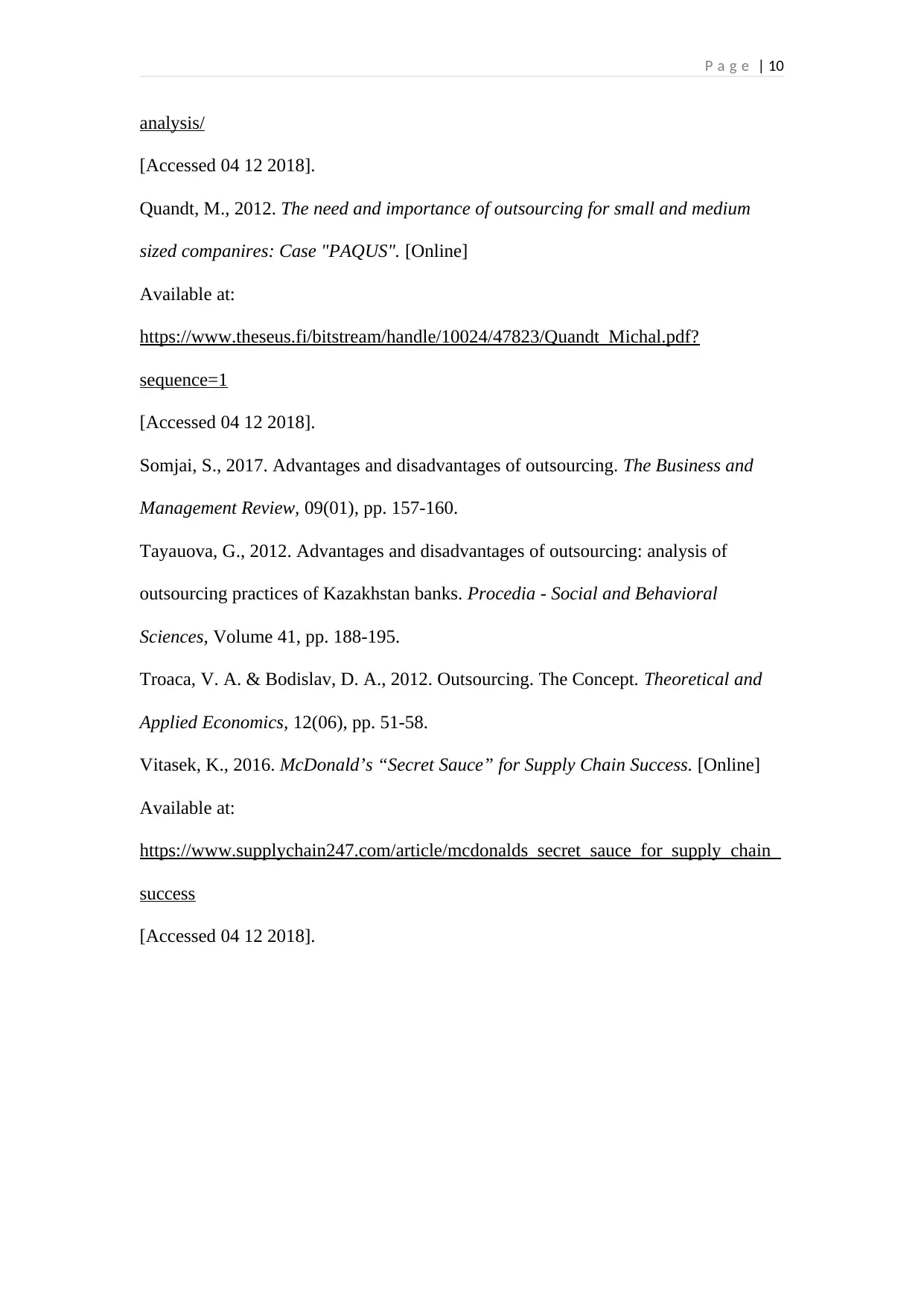
P a g e | 10
analysis/
[Accessed 04 12 2018].
Quandt, M., 2012. The need and importance of outsourcing for small and medium
sized companires: Case "PAQUS". [Online]
Available at:
https://www.theseus.fi/bitstream/handle/10024/47823/Quandt_Michal.pdf?
sequence=1
[Accessed 04 12 2018].
Somjai, S., 2017. Advantages and disadvantages of outsourcing. The Business and
Management Review, 09(01), pp. 157-160.
Tayauova, G., 2012. Advantages and disadvantages of outsourcing: analysis of
outsourcing practices of Kazakhstan banks. Procedia - Social and Behavioral
Sciences, Volume 41, pp. 188-195.
Troaca, V. A. & Bodislav, D. A., 2012. Outsourcing. The Concept. Theoretical and
Applied Economics, 12(06), pp. 51-58.
Vitasek, K., 2016. McDonald’s “Secret Sauce” for Supply Chain Success. [Online]
Available at:
https://www.supplychain247.com/article/mcdonalds_secret_sauce_for_supply_chain_
success
[Accessed 04 12 2018].
analysis/
[Accessed 04 12 2018].
Quandt, M., 2012. The need and importance of outsourcing for small and medium
sized companires: Case "PAQUS". [Online]
Available at:
https://www.theseus.fi/bitstream/handle/10024/47823/Quandt_Michal.pdf?
sequence=1
[Accessed 04 12 2018].
Somjai, S., 2017. Advantages and disadvantages of outsourcing. The Business and
Management Review, 09(01), pp. 157-160.
Tayauova, G., 2012. Advantages and disadvantages of outsourcing: analysis of
outsourcing practices of Kazakhstan banks. Procedia - Social and Behavioral
Sciences, Volume 41, pp. 188-195.
Troaca, V. A. & Bodislav, D. A., 2012. Outsourcing. The Concept. Theoretical and
Applied Economics, 12(06), pp. 51-58.
Vitasek, K., 2016. McDonald’s “Secret Sauce” for Supply Chain Success. [Online]
Available at:
https://www.supplychain247.com/article/mcdonalds_secret_sauce_for_supply_chain_
success
[Accessed 04 12 2018].
1 out of 11
Related Documents
Your All-in-One AI-Powered Toolkit for Academic Success.
+13062052269
info@desklib.com
Available 24*7 on WhatsApp / Email
![[object Object]](/_next/static/media/star-bottom.7253800d.svg)
Unlock your academic potential
Copyright © 2020–2025 A2Z Services. All Rights Reserved. Developed and managed by ZUCOL.





